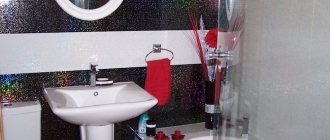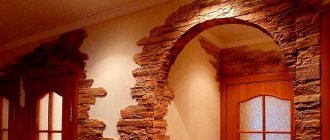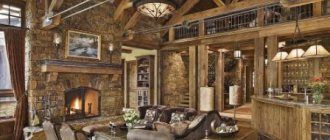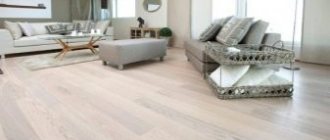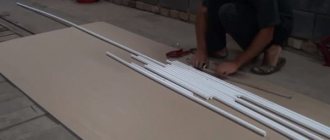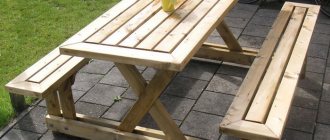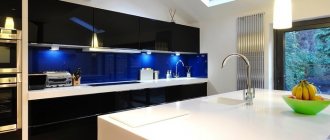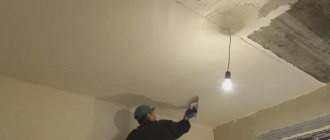Wall decoration with MDF panels is, today, one of the most popular jobs. The material has proven itself to be the most environmentally friendly and cheap compared to other wall panels.
If the finishing issue remains unresolved, MDF wall panels should be considered.
What are MDF panels?
The panels are produced using waste from wood processing enterprises. The composition does not contain harmful polymer resins that are released during operation and cause allergic reactions.
MDF (fine fraction) is made from tiny wood particles that are formed into a board by pressing.
The main ingredients are crushed sawdust, which is heated in ovens until lignin appears. Lignin is a natural resin secreted by wood, which is the binding element in the compressed board. The workpiece is cut to the required dimensions and covered with a special film to give it a beautiful wood texture or a variety of colors. But like any finishing material, MDF has its advantages and disadvantages.
The strength of such a connection is ensured by lignin, which is released from wood fibers as a result of high-temperature heating.
Advantages of wall panel:
- Availability. Thanks to cheap raw materials and simple manufacturing technology, the material has a low price.
- Easy to install. You can install MDF panels yourself without using complex tools or involving specialists.
- Appearance. The created wood structure on the surface creates a beautiful finish, and the variety in shades will allow you to match the panel to the tone of other materials.
- Undemanding to the base. When installing the panel to a wall using lathing, there is no need for additional surface preparation work.
Such wall panels have valuable characteristics that make them so popular.
The main disadvantages are the low resistance of the material to moisture and fire. And by installing the frame in the room, the useful area is reduced, but an additional air gap is created between the wall and the panel, this increases heat and sound insulation.
Such material does not pose a threat to human health.
Advantages and disadvantages
Before you buy MDF panels, you should know the main advantages of the material. Firstly, even if you don’t have the skills to decorate walls, you can quickly do a complete renovation with your own hands. In addition, it is also easy to install panels on the ceiling. When installation is done by yourself, there is no need for preliminary work.
The installation procedure is a finishing process. During the work there is little debris and dust, which in some cases is a determining factor. It is important to note that if you wish, you can quickly dismantle the panels. Knowing how to attach MDF wall panels, you can easily return the room to its original appearance.
Another important advantage is the high level of sound insulation and thermal insulation. In addition, if you want to clean the walls and ceiling, just wipe the surface with a damp cloth.
If you decide to mount panels, then there is a large selection of colors and original solutions for you - stone, wood, brick. At the same time, the price is pleasantly surprising.
As for the disadvantages, the panels have low moisture resistance. Although at the moment it is possible to attach MDF, which are specifically designed for bathrooms and kitchens. The next drawback is the low level of strength. If hit with a fist or ball, the material may deteriorate.
Another drawback is that MDF burns quickly. Therefore, before attaching the material, you should take care of fire safety.
Types of MDF wall panels
Manufacturers offer a large selection of types of finishing materials, differing in different characteristics, which can be selected for residential and commercial premises.
If all operating rules are followed, the panels last for a very long time.
Types of MDF panels:
- Form. Tiles - rectangular or square in shape with clear boundaries, which can be glued to the wall, are produced with interlocking joints. Lining – produced in the form of stacked elements with a mounting lock. Slab - used in rooms where the integrity of the finish is required, the seams are treated with decorative elements.
- Size. Width 150 – 900mm, length 2400 – 2700mm, thickness 3-9 mm depending on the shape of the product.
- Coating. Veneering – a thin layer of natural wood veneer is glued to the base of the panel and varnished. Lamination - the surface is covered with a melamine film that imitates a wooden surface. Painting – allows you to produce panels in different colors.
- Connection type. Locking – allows for quick and easy installation. Frame - creates a stronger connection with the base and makes it possible to lay communications in the cavity. Adhesive - the elements are attached to the wall using a special glue, but this type requires the most even surface possible.
Frameless method
It involves gluing the panels onto the prepared wall. The surface is cleaned of old paint and peeling plaster. All cracks are expanded and sealed with cement-sand or gypsum mortar. Uneven walls are plastered.
Wall cladding with MDF starts from the corner or floor of the room. Liquid nails are used for gluing - a durable and quick-drying material. They are applied to the inner surface of the panel with a snake or dots. To speed up the process, several panels are coated with adhesive at once.
The first element is pressed forcefully against the wall, then torn off and left to dry for 3-4 minutes. Apply it to the wall again, press firmly for 5-6 seconds and release. The first panel is glued. For greater strength, it is secured with 3 self-tapping screws, which are screwed into the groove.
The second panel is inserted into the groove and pressed. Then it is torn off and left to dry for 3-4 minutes. After this, the second panel is again inserted into the groove of the first and pressed. The remaining elements are mounted in the same way. The corner panel is cut taking into account a gap of 3-4 mm.
After covering the main surface of the wall, additional elements are installed. These can be internal and external corners, baseboards. They are also attached to liquid nails.
Application areas of panels
The strength of the material allows it to be used in all types of interior finishing work: wall paneling, floor covering with laminated sheets and ceiling cladding, installation of interior partitions and the manufacture of decorative interior elements. MDF is used in the production of furniture for facades and tabletops, interior doors and type-setting cladding elements.
Different decor options can be chosen according to the design of the room.
Uncoated MDF sheets are used for continuous roof sheathing and as additional heat and sound insulation material on all surfaces. Caution should be observed only in rooms with constant high humidity, which negatively affects the material.
They perform a protective function and also improve sound insulation.
Selection of quality panels for wall decoration
The durability and durability of the coating largely depend on the manufacturer and his compliance with all technological cycles during production. Many people try to save money on binding elements and add harmful resins to the composition; such material can no longer be called environmentally friendly.
Installation does not require radical changes to the walls and occurs quite quickly.
When choosing, you should give preference to European and domestic manufacturers who guarantee high quality and safety of products. Regardless of the type of room, it is better to cover the walls with panels with high moisture-resistant characteristics, which are impregnated with special compounds; this will prevent swelling and deformation of the panels when water gets on the surface.
More affordable compared to solid wood products. No costs required throughout the entire service life.
How to install panels yourself
Installing MDF panels on the wall with your own hands is quite simple; minimal skills in working with the necessary tools will be enough.
A wide range of models will allow you to find the right option depending on your preferences, purpose and budget.
Required tools and materials for installation:
- An electric jigsaw for cutting material to the required size; if the amount of work is small, you can get by with a hacksaw with fine teeth, so the cut edge will be more accurate.
- A tape measure for measurements and a building level for leveling the panels horizontally and vertically.
- A drill for drilling the necessary mounting holes and a screwdriver for attaching the material to the frame structure.
- Nails, dowels and screws or liquid nails for frameless installation.
- A wooden block with guide rails when making a wooden frame or a metal profile.
In order to save time and effort, it is better to carry out a large constant amount of work with power tools.
The installation process depends on the method of fastening; installing a frame system is a more labor-intensive process, but allows you to do without preparing the base. Makes it possible to install an additional insulating layer and lay communications into the wall cavity. The adhesive technology is simpler, but in order to avoid the panels moving away from the wall, it requires cleaning of old materials and final leveling of the surface.
MDF wall panels can be mounted in different ways.
Wall surface preparation and marking
Upon completion of the preparatory work on cleaning the walls and leveling, markings are made using a building level. It is necessary to determine the lower and upper attachment points and draw a horizontal line around the perimeter of the room. These lines will become the reference point for the guides, which are attached to the wall in increments of 50 cm. With correct measurements and drawing the horizon line, there will be no problems with installation.
The advantage of wood is ease of installation, environmental friendliness and the use of fewer hardware and connecting parts.
Installation Methods
There are only two ways to install MDF panels, each of which has its own advantages and disadvantages. Which method to choose depends on the condition of the walls in the room and the need for additional insulation.
Fastening the panel with glue
The easiest way is if you have a flat base. Before carrying out work on sheathing the wall, it is necessary to prime the base and treat it with an antiseptic.
It can not only be used for gluing, but also for leveling recesses in places where screws are screwed in.
Fastening with glue begins with solid sheets, and corner elements and fragments are fixed last. The glue is applied in a continuous line around the perimeter of the sheet and dotted in the middle. Next, the panel is pressed against the wall and fixed.
This method is suitable for covering the ceiling and floor in an apartment.
Frame installation
This method is used when the walls are very uneven and an additional insulating layer is required.
Please note that in rooms with high humidity, a metal frame is installed, and when installing a wooden structure, all elements must be treated with antiseptic compounds.
Installing a metal frame has its own difficulties - it requires a certain skill and the acquisition of special tools.
The design of the frame depends on the direction of fastening the panels to the wall; in the case of a horizontal direction, a vertical sheathing pattern is installed. When vertical, horizontal pattern.
Installation stages:
- The first guides are installed in the corners, then the transverse ones are attached to nails or screws.
- Regardless of the lathing material, a step of 40-60 cm is maintained between the slats.
- U-shaped hangers are installed on the slats in increments of 50-60 cm; these will be the mounting points for the panel.
- The ridge of the first corner panel is cut off and fastened with self-tapping screws to the fastening points, all subsequent elements are joined and secured.
How to beautifully join the corners of the panels
The final stage of wall cladding with MDF panels is the processing of corners and joints. Horizontal lines along the ceiling and floor are covered with skirting boards in the same color as the panels. For corners, special corners are sold, which, if carefully glued, will be almost invisible.
Gaps in the corner, as well as between the wall and the floor (ceiling), are closed using corners and decorative skirting boards (they can be glued on).
It is important that the calculation of additional elements and the purchase are best done immediately with the panels, otherwise there may be a significant discrepancy in color. All elements are attached to a thin layer of glue, and if excess appears on the surface, it is better to wait until it dries completely and then carefully scrape it off. “Liquid nails”, which are sold in different colors, are perfect for attaching all elements.
To eliminate gaps between slabs and mask seams, wood sealant is perfect; it can be chosen in the same color as the trim. Minor chips and scratches are well masked with wax pencils of different colors.
Installation of MDF panels
The procedure for attaching the panels is as follows:
- The panels are connected using a tongue and groove joint. For fastening to the sheathing, small nails are used, which need to be driven in obliquely, finishing them off with a striker and a hammer. To secure the panels to the metal profile, use special metal brackets - clamps. They are fixed in the groove of the panel and secured with self-tapping screws.
- When installed in a vertical position, the panels begin to be fastened from the corner, heading to the left.
- Attach the first panel to the block in the corner with nails or self-tapping screws, choosing fasteners depending on the type of sheathing, having first cut off the ridge. The groove side is fixed with nails or clamps.
- Secure the tongue of the next panel into the groove of the first. When installing the remaining panels, proceed in the same way - insert the ridge into the groove.
- The last panel is pre-cut to length, with an overhang of 2-5 mm, the ridge is cut in half. It is inserted into the groove of the previous house, and then fastened in a cut form from the side of the free edge using self-tapping screws.
- To finish the slopes, pieces of panels are used, which are fastened lengthwise and crosswise. For narrow slopes, they are fastened only across them; for wide ones, it is at the discretion of the owner.
- To close the corners, special MDF corners are used, under which the self-tapping screws holding the edge panels will be hidden. They need to be cut to size by rounding the corners and sanding the edges. They are attached with wood glue or liquid nails. Installation of MDF corners on the edges of panels located near windows and doors is similar.
If desired, the ceiling can also be covered with MDF panels, placing them perpendicular to the wall on which there is a window. The principle of creating a finish is the same as when attaching material to walls, however, unlike the first case, you cannot do without an assistant.
Useful recommendations for installing MDF panels on apartment walls
To avoid possible installation errors, follow a few tips:
- Buy material with a small margin, about 5% of the total volume for possible cuts.
- When facing a street wall that requires insulation, it is necessary to cover the base with a vapor barrier material.
- It is better to fix all fasteners with self-tapping screws; they are easier to unscrew in case of a possible mistake.
When covering the walls of an apartment with MDF panels, the house will always have a healthy and cozy atmosphere, and the interior will be transformed beyond recognition.
